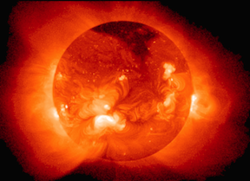Multiple Dimensions - Calculate The Mass Of The Sun
 As humans haven't been able to reach the sun, we have to work with mathematical models of the interior of the sun based on observations that are made from afar. The standard model of the sun assumes that the density of heated gas ( in grams per cm
) throughout the interior follows the best-fit formula
where
represents the core, and
represents the surface.
Given that the physical radius of the sun is
centimeters, what is the total mass of the sun (
in kg
)?
As humans haven't been able to reach the sun, we have to work with mathematical models of the interior of the sun based on observations that are made from afar. The standard model of the sun assumes that the density of heated gas ( in grams per cm
) throughout the interior follows the best-fit formula
where
represents the core, and
represents the surface.
Given that the physical radius of the sun is
centimeters, what is the total mass of the sun (
in kg
)?
This problem is part of Calvin's set Fun In Multiple Dimensions .
Hint: We are integrating along the radius. What is the corresponding area element?
This section requires Javascript.
You are seeing this because something didn't load right. We suggest you, (a) try
refreshing the page, (b) enabling javascript if it is disabled on your browser and,
finally, (c)
loading the
non-javascript version of this page
. We're sorry about the hassle.
We can assume the element to be concentric hollow spheres, having the same center as the sun. Let mass of the sun be M (in kg ), and the radius be R .( 1 R = 6 . 9 0 × 1 0 1 0 cm ).
For any general sphere with radius x , with thickness d x , its mass d M can be written as density times volume, i.e
d M = D × 4 π x 2 d x
D is in g / cm 3 , However, x is not in cm , x is in R .
Let's convert D to kg/R 3 (by multiplying ( 6 . 9 0 × 1 0 1 0 ) 3 and dividing by 1 0 0 0 ) to make calculations correct, and get final answer in kg .
d M = ( 6 . 9 0 × 1 0 1 0 ) 3 × 1 0 0 0 1 × ( 5 1 9 x 4 − 1 6 3 0 x 3 + 1 8 4 4 x 2 − 8 8 9 x + 1 5 5 ) × 4 π x 2 d x
M = ∫ d M = 4 π × ( 3 2 8 . 5 × 1 0 3 0 ) × 1 0 0 0 1 ∫ ( 5 1 9 x 6 − 1 6 3 0 x 5 + 1 8 4 4 x 4 − 8 8 9 x 3 + 1 5 5 x 2 ) d x
Since x goes from 0 to 1 , the limits on the integral will be 0 and 1
M = 4 π × ( 3 2 8 . 5 × 1 0 2 7 ) ∫ 0 1 ( 5 1 9 x 6 − 1 6 3 0 x 5 + 1 8 4 4 x 4 − 8 8 9 x 3 + 1 5 5 x 2 ) d x
M = 4 π × ( 3 . 2 9 × 1 0 2 9 ) × ( 7 5 1 9 − 6 1 6 3 0 + 5 1 8 4 4 − 4 8 8 9 + 3 1 5 5 )
M = 4 π × 3 . 2 9 × 1 0 2 9 × 1 4 0 9 7
M = 2 . 8 6 × 1 0 3 0 kg